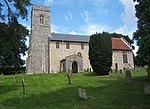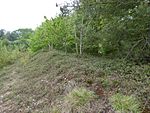Flixton Priory was a nunnery under a prioress following the Augustinian rule, which formerly stood in the parish of Flixton in the north of the English county of Suffolk, about 3 miles (4.8 km) south-west of Bungay. It was founded by Margery de Creke in 1258, and was dissolved in 1536–37. It was the poorest of the nunneries within the Diocese of Norwich. The site of the priory, which was enclosed by a moat, was at the present Abbey Farm, where little apart from the position in the landscape and a small section of standing wall remain to be seen. It was scheduled as an ancient monument in 1953. It is privately owned and is not open to the public. It is suggested that some parts of the masonry may have been re-used in St Peter's Hall at St Peter, South Elmham.
There are plentiful charters and other deeds and documents relating to the history of the priory. Eighty-four charters collected by Thomas Martin of Palgrave which were purchased by Thomas Astle entered the Stowe Collection, and passed from the Ashburnham Collection to the British Library. An 18th-century abstract of their contents is bound into the miscellaneous volume Stowe MS 1083, at fols. 56–84. Other Flixton charters owned by Thomas Astle are in the British Library "Carta Antiqua"; there is also a small but important series in the Lord Frederick Campbell collection. Several manorial rolls, rentals and other documents are among the Adair papers in the Suffolk Record Office at Lowestoft.
Flixton was among the feudal possessions of the Bishop of East Anglia at the time of the Domesday Survey, and together with Homersfield "is embedded in the tight-knit bundle of estates and churches of the bishop's fee known as South Elmham." The claim thus laid by Norman Scarfe is that this historic endowment of the bishops originated in a 7th-century grant to the first East Anglian bishop, St Felix, Bishop of Dommoc c. 631–648, and that Flixton itself (and also the other Flixton, in Lothingland) take their names from him. While this does not decide the various claims of South Elmham in Suffolk and North Elmham in Norfolk to be the seat of the second East Anglian Episcopal see of Helmham established by Archbishop Theodore, it does provide a context which in the 13th century may have recommended Flixton as an appropriate site for a religious foundation, in a commanding manorial seat a short distance from the pre-conquest parochial church.












